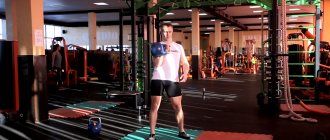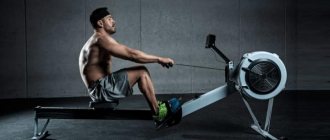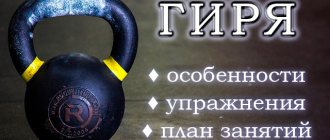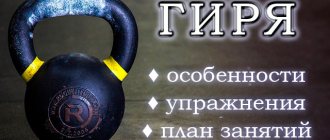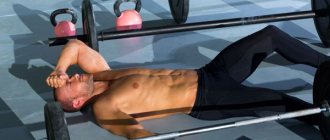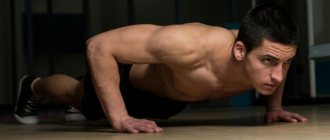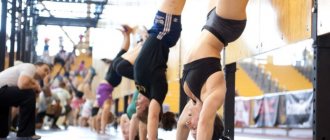Share:
CrossFit uses complex coordination exercises, borrowed mainly from sports such as weightlifting, artistic gymnastics, athletics, powerlifting, and kettlebell lifting. Today we will talk about one of these exercises – the push of two weights in a long cycle (Double Kettlebell Long Cycle).
Before moving on to the description of the technique, the following must be said: before including the described movement in your complexes, you need to carefully learn it, i.e. master each element of the movement with small weights, learn the whole movement, again with small weights, gradually master the exercise with a working weight, and only after that use it as part of complexes!
Rules for performing the exercise
Each exercise with weights is technically more difficult, so it is imperative to stretch your hands and shoulders well before starting the exercise so as not to injure your joints.
Initial position:
Raise the weights to your shoulders through a squat. Turn your wrists with your palms facing forward, your elbows close to your body. The gaze is directed forward. When the weights are on your chest, you should lean back a little so that it is in the middle of the center of gravity, in this position you should start.
Phase 1:
Perform a half-squat without changing the starting position, then with a pushing movement, straighten your legs at the knee joints, bending in the lumbar region. Lift off your heels to create momentum.
Phase 2:
Quickly bend your knees and then return your heels to the floor. The arms are fully straightened at the elbow joint. In the upper position, the hand is strictly vertical.
Phase 3 (Reset):
Rise up onto your toes and point your elbows forward. Drop the weights onto your shoulders. Elbows should be pressed to the body. This is your starting position
Since the clean and jerk is performed quickly, one inhale-exhale cycle is performed during the exercise, but at the top point, when the weights are above the head, the athlete must perform a couple more inhale-exhale cycles.
Correct technique for performing a kettlebell snatch
Phases of the jerk: 1 - start, 2 - swing, 3 - undermining, 4 - sitting down, 5 - fixing, 6 - lowering, 7-9 - swing to change hands, 10-13 - performing a jerk with the second hand.
The exercise is quite difficult. It is carried out in one movement, but in several stages:
The first phase is “Start”.
The athlete returns to the starting position. The weight lies on the floor and is located at an equal distance from the legs, which are spaced slightly wider than the shoulder girdle.
Second phase “Swing”.
You need to sit down a little, taking the projectile with your hands. You should not bend over, as this will not allow your leg muscles to engage in active work. The free hand should not encounter obstacles or rest on anything. Otherwise, the balance will be disturbed as a result of the fact that she was in front.
The body must not interfere with the movement of the weight, but accompany the projectile. This moment is especially difficult for beginners who stop the backward movement of the projectile, making their own jerk, and do not lead it to the end.
A correct swing assumes that the kettlebell, having reached the extreme point at the back, will begin to move forward (according to the law of the pendulum), therefore, with the explosive force of the back and legs, you need to give it even more additional energy.
Third phase "Detonation".
Having the weight in front of the athlete is a “signal” to straighten the legs and tilt the body back to give the apparatus the power necessary to complete the upward movement. No other efforts can be made.
The lack of disruptive energy does not allow you to make a breakthrough in any situation. Trying to lift a kettlebell up using your own efforts increases the risk of injury. When at this phase at the lowest point the efforts are not enough, the projectile will fly upward on its own. All that remains is to accompany him with your body and hand.
There is no need to hold the kettlebell with a death grip. It is enough to grasp the projectile with your fingertips. Of course, you can’t relax your grip too much so that the kettlebell just goes into free flight.
The fourth phase is “Squad”.
An optional stage, which is not present in every variety, but is mandatory in the classic version of the snatch. Otherwise, he will cease to be such. When the weight is as close as possible to the highest point, you need to bend under the projectile, that is, catch it.
Performing a squat allows you to take as much weight as possible and also significantly save energy. This is especially important for those who need to pass standards.
Squats are needed to cushion a heavy projectile. They help reduce the negative load placed on the joints. Anyone who wants to learn how to do a jerk should definitely master this phase.
Fifth phase “Fixation”.
When squatting, the apparatus is twisted in such a way that it becomes possible to hold the weight at the upper extreme point. There are different ways to do this. The choice depends entirely on the wishes of the athlete and how easy it is, taking into account the anatomical features, to make this or that fixation.
The constant point of this phase is that fixation of the projectile in the hand must be ensured even before the end of the movement. At the very end, you need to fully straighten your arm. This should not be done too early. Completing the movement with the arm already straight will cause serious damage to the shoulder and elbow joints.
They experience a lot of stress even when the fixation is performed absolutely correctly. When doing the snatch, you should pay special attention to stretching and strengthening the shoulder and elbow joints. You need to take care of the carpal ligaments. They must be stretched. When the weight is held at the end point, they bend back.
When the athlete stands with the kettlebell held with an outstretched arm, he should lean forward slightly. This allows you to maintain balance.
Sixth phase “Lowering”.
It can be carried out in two ways - directly on the floor surface or with a transitional movement, when the projectile is first “placed” on the chest, and only then lowered, that is, similar to a push.
Competing athletes practice exclusively the first option. For athletes who do not demonstrate this exercise in competitions, the second method is more suitable. It's much safer. Regardless of the option you choose, you should not throw the projectile.
The kettlebell should always be cushioned by the body. If the movement is sudden and uncontrolled, the likelihood of injury increases. A falling weight can easily cause a lot of damage.
To quickly master the technique and prevent injuries, just follow a few simple tips:
- It is best to hone the technique on a light weight projectile, but it must be noticeable. The best option for women would be a ten-kilogram weight, for men - sixteen kilograms.
- Beginners who want to master the snatch should thoroughly work out their muscle frame. Otherwise, you simply won’t be able to complete the exercise. Performing deadlifts and standing presses with a barbell, as well as jerking and lifting weights on the chest, will allow you to cope with this task perfectly.
- No tearing or straining forces should be allowed when performing any phase. You need to make sharp, clear and coordinated, slightly smooth movements.
- You need to be careful to keep your free hand relaxed, but not flailing or twitching. You should not forcefully hold it in one position. The main thing is that it should not interfere with muscle work and overexert itself.
The duration of each jerk is largely determined by the athlete’s own endurance. The approach time can vary between 3-15 minutes.
The benefits of pushing two weights
- It strengthens the ligamentous apparatus. This occurs due to the displaced center of gravity of the projectile.
- Affects the synthesis of testosterone in the body. Due to the fact that the load is distributed both on small muscle groups and large ones, such as the muscles of the legs and back.
- Helps develop explosive strength. This occurs due to the impulsive nature of the execution technique.
- Helps strengthen coordination endurance.
- Develops strength endurance. Due to the constant static load on the shoulder muscles and the multi-repetition style of pushing.
Working muscles and joints
During the kettlebell push, a large number of different muscle groups work, the main ones being the legs, long back muscles, anterior deltoid, pectoralis major, triceps, biceps and forearm. Some muscles work more, some less, which, in particular, depends on the technique of performing the push, but, nevertheless, the push allows you to work almost the entire body. Dynamic work is primarily performed by the triceps, legs and deltoids, while the biceps, forearms and long back muscles act as stabilizers. Pay special attention to the work of the long muscles, since they control the position of the spine, so if you have them poorly developed, they should be worked in deadlifts or reverse hyperextensions.
Since the exercise involves a large number of muscle groups, it goes without saying that the push also involves a large number of joints, which share the load among themselves. However, since the kettlebell jerk is not only a multi-joint, compound exercise, but is also a multi-joint exercise, different joints are worked at each stage. If during the bench press the load is distributed permanently between the elbow and shoulder, then, for example, the knee joint in the push sometimes works, sometimes it doesn’t work. That is why it is especially important to practice coordination of movements, their synchronization and sequence, so as not to get confused and not cause injury to yourself.
Alternative replacements for the two-handed kettlebell push
Kettlebell push with one hand. This exercise is perfect for beginners because it has the simplest technique, but also uses the deltoids and trapezius muscles.
Kettlebell push with one hand
Full cycle push of the kettlebell. This exercise involves raising and lowering a kettlebell to the floor for each repetition. It develops endurance and is more difficult compared to the one- and two-handed kettlebell push.
Long cycle kettlebell push
Army barbell standing press. This exercise is aimed at strengthening the entire shoulder girdle. This will help you perform the two-handed kettlebell push with more repetitions, and will also help you keep the kettlebells in the top position.
Standing barbell press (military)
Auxiliary exercises
Kettlebell push with one hand. This exercise is perfect for beginners, since it has the simplest technique of execution, and also involves the deltoid, trapezius muscles, and when undermining, the erector spinae muscles.
Lifting weights to the chest from a hanging position. The main load when performing the exercise is received by the deltoid muscles, as well as the erector spinae muscles. To perform the double kettlebell jerk, you must have a strong back and shoulder girdle, so doing a kettlebell clean will help you get closer to performing the double kettlebell jerk.
Historical background and some facts
Kettlebell-like equipment was made and used for training by Olympians in Ancient Greece. In the Dark Ages, when the cult of a healthy body was forgotten, there was no mention of this sports equipment for a long time. In the modern period, weights began to be used in trade to measure weight.
They returned to the category of sports equipment from the 19th century, but solely for the development of the body, and not for obtaining any achievements. Kettlebells were mainly used by circus performers to entertain the public. Exercises with weights received official recognition much later - towards the end of the same century. They entered the training program and became one of the varieties of weightlifting.
Kettlebell lifting became an independent discipline in the middle of the 20th century. The first competition among strongmen was held in 1948 in the USSR. The rules by which the competition took place were not clearly regulated. The competition itself turned out to be significant, as it gave kettlebell lifting the status of a professional discipline, and the apparatus began to become popular among people involved in their physical development.
The current rules for kettlebell lifting were formed in the early 90s. The world record for the snatch belongs to Sergei Trifonov, who performed 1,501 repetitions with a pound weight in 1 hour.
Crossfit complex
The two-kettlebell push is an exercise that was transferred to CrossFit from kettlebell lifting and is no less popular there. The following is a version of the CrossFit complex involving the push of two weights.
Objective: perform 5 rounds, in each of which the number of repetitions is reduced by 10. Start with 50 repetitions (50-40-30-20-10). The complex is performed for a while.
| September |
|
Training program
The following complex is suitable for athletes with some experience in kettlebell lifting who want to increase their results in the jerk of two kettlebells. It is also great for preparing for competitions.
For successful training, it is advisable to have the following set of weights: 16, 20, 22, 24, 26, 28 kg. As a last resort, you can use dumbbells.
6 week program:
| Week 1 | |
| Workout 1 | |
| 24 kg | 2 minutes |
| 20 kg | 3 min |
| 16 kg | 4 min |
| Workout 2 | |
| 24 kg | 3 min |
| 20 kg | 4 min |
| 16 kg | 5 minutes |
| Workout 3 | |
| 24 kg | 4 min |
| 16 kg | 6 min |
| Week 2 | |
| Workout 1 | |
| 24 kg | 2.5 min |
| 20 kg | 3.5 min |
| 16 kg | 4.5 min |
| Workout 2 | |
| 24 kg | 3.5 min |
| 20 kg | 4.5 min |
| 16 kg | 5.5 min |
| Workout 3 | |
| 16 kg | 8 min (walking) |
| Week 3 | |
| Workout 1 | |
| 26 kg | 2 minutes |
| 24 kg | 3 min |
| 20 kg | 4 min |
| Workout 2 | |
| 26 kg | 3 min |
| 24 kg | 4 min |
| 20 kg | 5 minutes |
| Workout 3 | |
| 26 kg | 4 min |
| 20 kg | 6 min |
| Week 4 | |
| Workout 1 | |
| 26 kg | 2.5 min |
| 24 kg | 3.5 min |
| 20 kg | 4.5 min |
| Workout 2 | |
| 26 kg | 3.5 min |
| 24 kg | 4.5 min |
| 20 kg | 5.5 min |
| Workout 3 | |
| 20 kg | 8 min (walking) |
| Week 5 | |
| Workout 1 | |
| 28 kg | 2 minutes |
| 26 kg | 3 min |
| 24 kg | 4 min |
| Workout 2 | |
| 28 kg | 3 min |
| 26 kg | 4 min |
| 24 kg | 5 minutes |
| Workout 3 | |
| 28 kg | 4 min |
| 24 kg | 6 min |
| Week 6 | |
| Workout 1 | |
| 28 kg | 2.5 min |
| 26 kg | 3.5 min |
| 24 kg | 4.5 min |
| Workout 2 | |
| 28 kg | 3.5 min |
| 26 kg | 4.5 min |
| 24 kg | 5.5 min |
| Workout 3 | |
| 24 kg | 8 min (walking) |
You can also download this program from this link.
An important point is the pace of the kettlebell push. If you want to achieve a result of 24 per 100 times, then 16 kg - 14-16 times/minute, 20 kg - 12-14 r/m, 24 kg - 10-12 r/m, 26 kg - 8-10 r/m , 28 kg - 6-8 r/m.
You can watch the technique of proper breathing in the following video:
Recipes for healthy eating
Salad with beans, croutons and smoked sausage
- 5.6 g Protein
- 6 g Fat
- 16.5 g Carbohydrates
- 142.2 kcal
30 min.
- #second course
- #greenery
- #yogurt
- #sausage
- #carrot
- #dinner
- #snack
- #salad
- #salted cucumbers
- #spices
- #dinner
- #beans
Other recipes
Kettlebell lifting: classic clean and jerk, snatch, long cycle jerk
- Classic push
- Jerk
- Long cycle push
In the previous article, I reviewed the general training methodology in kettlebell lifting and promised that I would further detail the main exercises of competitive kettlebell lifting.
So, competitive kettlebell lifting, namely its main exercises. I would like to start the analysis with the heaviest exercise - the kettlebell push.
This exercise is considered one of the most difficult in kettlebell lifting, both in terms of the physical and functional capabilities of the athlete.
The push itself in kettlebell lifting is presented in two versions: the classic, or so-called short push, and the long cycle push.
Classic push
The classic clean and jerk, along with the kettlebell snatch, is part of the kettlebell double event. The exercise is performed as follows: after the command
“Start” the athlete throws the weights onto his chest and begins lifting them up. The competition goal is to complete the most lifts within 10 minutes. I would like to describe some of the nuances of this exercise, namely the position of the hands, the position of the legs, the position of the weight in the palm.
So, at the beginning of the push, the athlete is in the starting position, the weights are on the platform in front of the athlete. At the “Start” command, the athlete throws weights onto his chest and begins lifting.
To begin with, I would like to talk about the position of the weight in the athlete’s palm.
When throwing, the weight should be positioned in the palm of your hand in such a way that the possibility of it falling out during the exercise is excluded.
note
The only correct option for the location of the weight is, so to speak, a diagonal arrangement in the palm: the bow of the weight is located diagonally - the base of the index finger of the hand - the base of the palm.
It is with this arrangement of the bow that involuntary displacement or loss of the projectile is completely eliminated. It should be noted that this position of the arch is similar when performing all kettlebell lifting exercises.
Further, after throwing, or rather simultaneously with throwing weights onto the chest, the athlete sets his elbow joints in such a way as to most effectively use them as levers during the lifting process. The elbow joints are installed on the iliac crests.
In this position, the arms are most resistant to the load and are most effectively used when pushing weights. A good option for those athletes whose arm length does not allow the elbow joint to be positioned correctly is to use a weightlifting belt.
I would like to say a few more words about the positioning of the legs in the clean and jerk.
The legs should be positioned in such a way as to ensure the greatest efficiency of work, namely pushing.
Since the legs are also used as levers, they need to be installed in such a way that all the force when pushing goes upward.
Thus, the most effective position will be to position your feet shoulder-width apart or slightly narrower. In this position, all the pushing force will be directed upward.
Important
So, when performing a push, the athlete from the initial position “weights on the chest, legs shoulder-width apart” performs a small half-squat, followed by a sharp push with the legs and a simultaneous whipping forward-upward movement of the pelvis, thereby transferring the force to the elbow joints and pushing the arms with the weights up.
Simultaneously with the hands with the weights reaching the end point at the top, a second, deeper squat is performed. This is necessary to make the work of the hands easier - as if the athlete is diving under the weights.
Next, the legs are straightened and the weights are briefly held above the head in the fixation position, with further lowering to the chest for the next lift.
The next exercise in classic kettlebell lifting is the kettlebell snatch.
The snatch can, as described above, be included in the classical combined event program along with the clean and jerk - for men - or be represented as a separate competitive exercise for women.
The snatch, unlike the clean and jerk, is performed with one kettlebell for 10 minutes with each hand alternately. When performing a snatch, only one change of hands is allowed.
So, jerk.
When performing a snatch, the athlete begins the movement from the initial “kettlebell down” position. In the trajectory of movement of the weight in a snatch, we can conditionally distinguish 4 points: the point of swing, the point of detonation of the weight, the point of inserting the hand into the arch of the weight, and the end point - the point of fixation of the hand with the weight.
Let's take a closer look at the entire trajectory of the weight's movement. The swing point is the extreme point from which the forward and upward movement of the weight begins. To perform the exercise most effectively, this point should be located as far back as possible between the athlete’s legs.
This is necessary for maximum inertial force when moving the weight, in order to reduce the load on the arm muscles. So, from the point of the swing, the weight begins an inertial movement forward and upward.
However, the force of inertia is not infinite and the weight sooner or later slows down and stops its inertial movement.
Advice
The point at which the inertial force stops moving the weight is the point at which the weight explodes. At this point, the athlete begins to apply his own effort to further lift the projectile. So, what are the actions of the athlete when the trajectory of the weight reaches the detonation point?
When the trajectory of the weight reaches the detonation point, the athlete must make certain efforts to ensure its further movement. At the point of detonation, the athlete makes a sharp reverse movement of the shoulder joint of the arm with the weight back and up, which creates additional force for further movement of the weight.
The next point of movement of the weight is the point where the hand is inserted into the arch. This happens when the projectile is at the level of the athlete's head.
Next comes fine-tuning the hand with the weight and directly fixing it.
- Detonation
- Fixation
- Fixation Rotation of the weight
- Interception of the bow
- Lowering the kettlebell into the backswing
- Interception of the bow
What is a long cycle push, or just a long cycle, as it is commonly called in kettlebell lifting?
The long cycle is the most difficult exercise both from the point of view of execution technique and from the point of view of the athlete’s physical expenditure. This is due to the work that the athlete performs.
When performing the exercise, almost all major muscle groups are involved: muscles of the back, legs, arms, shoulder girdle.
The technique of performing the exercise is similar to the technique of performing the classic push. However, there are also distinctive features, which consist mainly in the dumping and throwing of weights.
So, the starting position when performing a long cycle push, in contrast to the classic push, is the kettlebell hanging below. From this position, the athlete performs a throw to the chest, followed by pushing out and lowering to the starting position - this is one cycle or one lift.
There are two options for performing this exercise: with a quick release of the weights and with a pause in the position on the chest.
note
The choice of one or another execution option depends on the physical and functional capabilities of the athlete, although there are cases when athletes, depending on the time period, change one option to the second. This is again often due to their physical and functional condition.
So, let's start with throwing weights from a hanging position. The throw is carried out by a sharp movement of the arms and shoulders forward and upward - the so-called undermining, followed by placing the elbows similarly to the classic push.
The peculiarity of casting is that the athlete must choose the necessary trajectory of movement of the arms with weights, which will most effectively and with the least energy consumption allow the weights to be thrown onto the chest.
I suggest considering the following casting option.
When the hands come out of the swing, at the end of the inertial movement, the athlete explodes the weights.
It is important to move your elbow joints out to the sides or up as little as possible, which will significantly reduce energy costs when performing the exercise.
Next is dropping the weights.
After performing a push, the athlete needs to lower the weights to their original position - down.
It goes like this. The athlete performs a sharp release of weights either immediately, along a tangential trajectory, down, or with preliminary emphasis on the crests of the iliac bones.
Important
When resetting, an important nuance is the further trajectory of the weights. Thus, some athletes begin casting from a hanging position with the weights below without preliminary inertial movement of the weights back and forth.
This option is undoubtedly the most energy-consuming and, as a result, the least effective.
The most effective option from the point of view of energy consumption will be when, after releasing the weights, they move backward by inertia until they reach a stopping point, after which they begin to move forward inertially. The athlete’s hands are as relaxed as possible at this time.
To unload the leg muscles, you need to do pendulum movements, relaxing the quadriceps muscles at the end points. I would also like to consider the damage to the athlete’s legs when performing a long-cycle push.
As in the classic clean and jerk, the ideal position of the legs when performing the exercise should be “shoulder-width apart”, however, due to the technical features of the execution, this position cannot always be used.
So, if an athlete, when releasing the weights, rotates them around its axis, due to the peculiarities of the placement of the weights, it is very difficult to carry out their movement in the swing if the legs are located close enough to each other.
In this case, an additional step to the side can be used when making a swing. If, when releasing the weights, the athlete does not rotate them, and the weights move in parallel, then a narrow stance of the legs will not be a big hindrance during the swing.
In this material, I tried to describe in as much detail as possible the technique of performing the basic exercises of competitive kettlebell lifting. In subsequent issues we will pay attention to the training methods for these exercises.
How to pump up your shoulders with kettlebells. Respiratory system
If you breathe correctly when performing any exercise, the process of shaping your body will move to a higher quality and safer level. It is especially important to be able to breathe when performing strength exercises with weights.
When performing exercises with a 16 kg, 24 or even 32 kg kettlebell, it is important to learn how to combine movements with even breathing.
In this case, it is necessary to strictly follow the execution technique and relax the muscles during activities that are not involved at the moment.
Under no circumstances should you hold your breath while working - this will lead to oxygen depletion and you will feel tired faster without completing half of what you should.
Calculate your ideal sports weight!
Pay special attention to all methods of belaying when working with heavy weights. For those who want to disregard precautions, I advise you to read materials about what the consequences of a negligent attitude to technology and safety methods may be. Here is a good example: https://hospital.ukr/intervertebral-hernia, see for yourself that working with iron requires a careful approach.
Kettlebell snatch. Respiratory system
There are several breathing systems that are practiced when performing a kettlebell snatch; the three-cycle system is considered the easiest and most convenient.
While lifting the weight, before the squat is done, inhale, which ends simultaneously with the completion of the lift. There is a small nuance : breathing must correspond to the actions and then it will be natural.
When lifting, we inhale at a free pace, and during a lift, we finish the inhalation with the same energetic impulse. We keep tact.
When the body is fully straightened, immediately after lifting the weights, at the moment of transition to performing a squat, we take a deep but very quick breath. Next we have a half-squat and straightening of the arm at the top - we exhale. Literally a split second before lowering, take a quick breath, and then, at the end of the movement, we exhale freely, which ends when the weight is brought into the knee swing.
What kettlebell weight is acceptable for strength exercises?
The most common weights are 16, 24 and 32 kg. When an athlete’s goal is to pass the GTO standards, the projectile jerk is done with minimal weight. The point here is that the athlete must lift the weight as much as possible and hold it in that position for 4 minutes. To fulfill the standard, sufficient physical training is required, so not everyone can pass it properly. Thus, before reaching the age of 40, men need to demonstrate a 16 kg kettlebell snatch no less than 40 times to pass the GTO. If performed successfully, he becomes the owner of a gold TRP badge.
Athletes who are just starting to train with kettlebells should work with a weight of no more than 32 kg. For women there are special weights weighing 10 kg or less. Kettlebell training is preceded by preparatory exercises, including push-ups and deadlift exercises.
The athlete must perform one number of repetitions with both hands. If the hands have different physical strength and training, classes should begin with the one that is weaker. To build endurance, the recommended training time is 10 minutes with a possible large number of approaches.
